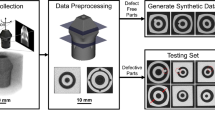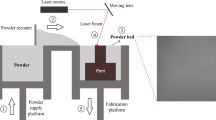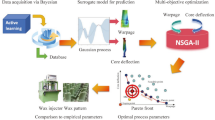Abstract
Prediction of paint properties is a critical issue for the coatings industry, since experimentation is time consuming and a lot of financial and human resources are needed to test or develop new products. In current market conditions, cost savings and product innovation are critical issues. In this article, an artificial neural network, of the feed forward type, was trained using as inputs key properties of titanium dioxide and two formulation parameters (pigment volume concentration and titanium dioxide content) for a water-based architectural coating. The outputs of this research were spread rate, color (L*, a*, b*) and tinting strength. Test data were used to check the accuracy of the model, demonstrating the viability of paint properties prediction related to the properties of the titanium dioxide formulation with high correlation (>95%).
















Similar content being viewed by others
References
ANAFAPYT (Asociación Nacional de Fabricantes de Pinturas y Tintas). Estudio de Mercado de pinturas (2008)
Vitela, J, Achar, E, “Modeling, Prediction and Analysis of Alkyd Enamel Coating Properties via Neural Computing.” J. Coat. Technol. Res., 3 (2) 141–149 (2006)
Aragón Candelaria, Pablo René. Valor en uso del bióxido del titanio para la fabricación de recubrimientos arquitectónicos. Tesis de Maestría en Administración de Empresas. Universidad Anáhuac México Sur (2007)
Werner, R, “Effect of Extenders with Narrow and Broad Particle Size Distributions on the Properties of Coatings.” J. Coat. Technol., 72 (903) 71–75 (2000)
Polyakova, A, et al., “Effect of Formulation Variables on Coating Properties and Performance in the Deep Draw Process.” J. Coat. Technol., 72 (901) 69–75 (2000)
Chicago Society for Coatings Technology Technical Committee (CSCTTC), “A Study of the Effect of Different Iron Oxide Grades on Properties of an Industrial Latex coating.” J. Coat. Technol., 72 (901) 91–99 (2000)
Warne, K, et al., “Statistical and Computations Intelligence Techniques for Inferential Model Development: A Comparative Evaluation and a Novel Proposition for Fusion.” Eng. Appl. Artif. Intell., 17 871–885 (2004)
Thorton, CJ, “Introduction to Connectionist Computing.” Comput. Aided Design, 9 530–537 (1991)
Nascimento, CAO, et al., “Use of Neural Networks in the Analysis of Particle Size Distributions by Laser Diffraction.” Powder Technol., 90 89–94 (1997)
Kohonen, T, “An Introduction to Neural Computing.” Neural Netw., 1 3–16 (1988)
Cross, SS, et al., “Introduction to Neural Networks.” Lancet, 346 1075–1077 (1995)
Basheer, IA, et al., “Artificial Neural Networks: Fundamentals, Computing, Design, and Application.” J. Microbiol. Methods, 43 3–31 (2000)
Najjar, Y, et al., “Computational Neural Networks for Predictive Microbiology: I. Methodology.” Int. J. Food Microbiol., 34 27–49 (1997)
Zupan, J, Gasteiger, J, “Neural Networks: A New Method for Solving Chemical Problems or Just a Passing Phase?” Anal. Chem. Acta, 248 1–30 (1991)
Rumelhart, DE, Hinton, GE, Williams, RJ, Learning Internal Representations by Error Propagation. Parallel Distributed Processing, Vol. 1. Foundations, pp. 318–335. MIT Press, Cambridge, MA (1986)
Owens, AJ, Filkin, DL, “Efficient Training of the Back Propagation Network by Solving a System of Stiff Ordinary Differential Equations.” International Joint Conference on Neural Networks, Vol. 2, pp. 381–386 (1989)
ASTM (American Society for Testing and Materials). Standard Test Method for Oil Absorption of Pigments by Spatula Rubs Out. Annual Book of Standards. Vol. 06.01. ASTM D281-95 (2007)
Horiba Instruments. Particle Size Distribution Analysis System. Horiba LA-950. http://www.horibalab.com/page.php?id=304
Winkler, J, Titanium Dioxide. European Coatings Literature, pp. 63–67. Vincentz, Hanover (2003)
ASTM (American Society for Testing and Materials). Calculation of Color Differences from Instrumentally Measured Color Coordinates. Annual Book of Standards, Vol. 06.01, pp. 226–229. ASTM 2244 (2001)
ASTM (American Society for Testing and Materials). Hiding Power of Paints by Reflectometry. Annual Book of Standards, Vol. 06.01, pp. 324–329. ASTM 2805 (2001)
ASTM (American Society for Testing and Materials). Relative Tinting Strength of White Pigments by Reflectance Measurements. Annual Book of Standards, Vol. 06.01, pp. 324–329. ASTM 2745 (2001)
Piovoso, MJ, Owens, AJ, “Sensor Data Analysis Using Artificial Neural Networks.” Chemical Process Control CPC IV, AIChE, pp. 101–118 (1991)
Acknowledgments
The authors extend their gratitude to Juan Gomez and Elizabeth Rauda for the laboratory work performed. Gratitude is also expressed for their continuous support in this study to Carlos Verdejo, Miguel Gama, and Roberto Giesemann. Special mention to Dr. Michael Diebold for his comments on the paper.
Author information
Authors and Affiliations
Corresponding author
Additional information
The information set forth herein is furnished free of charge and based on technical data that DuPont believes to be reliable. It is intended for use by persons having technical skill, at their own risk. Since conditions of use are outside our control, we make no warranties, expressed, or implied and assume no liability in connection with any use of this information. Nothing herein is to be taken as license to operate under or a recommendation to infringe any patents.
Rights and permissions
About this article
Cite this article
Aragón Candelaria, P.R., Owens, A.J. Prediction of architectural coating performance using titanium dioxide characterization applying artificial neural networks. J Coat Technol Res 7, 431–440 (2010). https://doi.org/10.1007/s11998-009-9215-z
Published:
Issue Date:
DOI: https://doi.org/10.1007/s11998-009-9215-z




